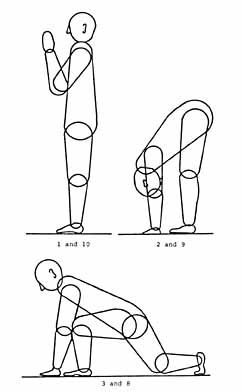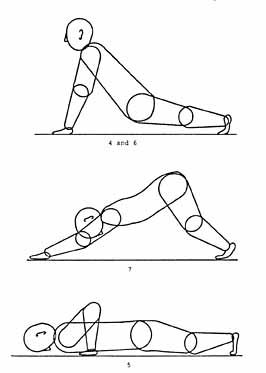Surya Namaskar
Surya namaskar (lit., salutation to the sun) is a hybrid exercise which integrates aspects of vyayam training with yogic asans. While based on formal yogic principles, surya namaskar also serves to develop physical strength. Although surya namaskars have undoubtedly been practiced for centuries (cf. Mujumdar 1950), the exercise was routinized and made popular by the late raja of Aundh, Bhawanrao Pantpritinidhi. Raja Bhawanrao believed that if everyone performed this exercise religiously, the result would be a stronger and more upright nation (Mujumdar 1950: xxiv). In a book entitled Surya Namaskars, Bhawanrao’s son, Apa Pant, makes the following observation:
It is precisely this kind of experience which Bhawanrao was attempting to transpose onto a national level to the end of ethical and moral reform. In the beautiful and harmonized movements of surya namaskar, Bhawanrao clearly saw the harmonized body of a united Indian polity that would turn, collectively, away from the gross sensations of modern life—sex, drugs, power, pride, prosperity (ibid: 12–14)—and toward the pure experience of self-realization.[Surya namaskar] is not a religious practice in the narrow sense of the term. But it does have a deep spiritual content and it opens up a new, more profound, more powerful dimension of awareness. Slowly but surely as one continues regularly to practice it, things change in you and around you. Experiences miraculously come to you and you feel the full force of the Beauty and Harmony, the unity, the oneness, with all that is (A. B. Pant 1970: 2).
Surya namaskar consists of ten body postures which together constitute a rhythmic flow of motion (see figures 1a, b). Each posture is punctuated by the recitation of a short mantra to the rhythmic cadence of pranayama.
To perform surya namaskar one should clear a space at least two and a half meters long by one meter wide. This space should be oriented towards the rising sun. One should wear as little as possible so that movement will not be inhibited.
Position One: With feet together and back and legs straight but not rigid, bend your arms at the elbow and fold your hands in front of your chest. Breathe in deeply through your nose with full concentration. Focus your mind on your posture and your breath.
Position Two: From position one, bend and place your palms flat on the ground on either side of your legs. Your palms should be a forearm’s length apart. Keep your legs straight and touch your nose to your knees. Keeping your arms straight, tuck your chin into your chest. Breathe out slowly and evenly as you reach this position. Always breathe with your stomach: in, stomach out; out, stomach in.
Position Three: From position two extend one leg back as far as it will go and touch the knee to the ground. Arch backwards at the same time and lift your head back as far as it will go. Breathe in while doing this and push your stomach out. Always be alert and concentrate on each movement, breath, and sensation. At the same time remain detached and relaxed.
Position Four: Move your second leg back so that both legs are extended backwards. Lift both knees off the ground so that your weight is supported on your palms and toes while your body is held straight. Touching your chin to your chest, look down at the ground between your palms. Hold your breath in this position.
Position Five: This is the most important and central position of the exercise. Bend at the elbows so that your body descends to the ground. Insure that your body touches the ground at only eight points: the two sets of toes, the two knees, chest, forehead, and the two palms. This part of the surya namaskar is called the ashtanga namaskar, or eight-pointed salutation. All eight points must touch the ground at the same time. As they come in contact with the ground you should exhale.
Position Six: In order to move from the fifth to the sixth position lift your head up and bend your neck backwards. Then, without exerting pressure on your arms, lift the trunk of your body off the ground by contracting your lower back and gradually extending your arms. Your spine should be fully arched from the top of your neck to the base of your tailbone. Breathe in while assuming this position and again concentrate on each part of your body.
Position Seven: In position seven you reverse the arch of your body by lifting your buttocks into the air as far as possible while extending your arms and legs. Your hands and feet should not move. Breathe out in this position.
Position Eight: This position is a repetition of position three. It is achieved by moving one foot forward and placing it between your palms. Arch your back and bend your head backwards. Breath in deeply.
Position Nine: Bring your other leg forward and place both feet together. Straighten your legs and tuck your chin into your chest. Breathe out with force. This is a repetition of position two.
Position Ten: This position brings you back to the starting point of the exercise. Breath in as you stand erect and fold your hands in front of your chest.
While doing surya namaskars one is enjoined to recite six bij mantras (seed sounds). Not only does one pay obeisance to the sun by reciting these mantras, they also reverberate through the body in an efficacious manner. Pant points out that these reverberations invigorate the mind (1970: 9). There are six primary bij mantras: Om-Haram; Om-Harim; Om-Harum; Om-Haraim; Om-Harom; Om-Hara. In accompaniment to the six bij mantras one should recite the twelve names of the sun: Mitra (friend); Ravi (shining); Surya (beautiful light); Bhanu (brilliant); Khaga (sky mover); Pushan (giver of strength); Hiranya Garbha (golden centered); Marichi (Lord of the Dawn); Aditya (son of Aditi); Savitra (beneficient); Arka (energy); and Bhaskara (leading to enlightenment).
Surya namaskars integrate and harmonize all aspects of the physical, intellectual, and spiritual body. Position two energizes the pituitary, pineal, and thyroid glands. Position three stimulates the liver, solar plexus, and pancreas. Position four stretches the spinal column and facilitates blood flow to all of the organs and glands in the immediate vicinity of the spine. Positions five and six are particularly efficacious for the neck, chest, abdomen, and sexual glands. The regular performance of surya namaskars is intended to raise one’s state of consciousness to a higher level of self-realization. As Pant notes, one can then transpose this experience of self-realization—which he refers to as bliss, harmony, knowledge, beauty, and awareness of the infinite—onto one’s experience of everyday life.
Surya namaskars are more popular among older men than among young wrestlers. While they strengthen the body, they do not strain the muscles, bones, and organs of the body. Surya namaskars are not vigorous, and senior wrestlers practice them in order to maintain their physique and stature. In any case, surya namaskars are clearly associated with physical strength and muscular prowess. Shivaji’s guru, Samarath Ramdas, was said to perform 1,200 surya namaskars every day. Shivaji himself and Ramdas’s other disciples also performed surya namaskars. Mujumdar attributes Maratha physical prowess and military success to this exercise (1950: 54).
With regard to wrestling discipline, surya namaskar is important insofar as it represents the formal synthesis of yoga and vyayam. This synthesis is implicit in many of the exercises which wrestlers do. As we shall see, the combination of dands and bethaks echoes the basic movement of surya namaskar.

